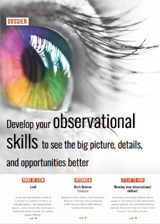Observation skills: struggle against your natural observational preferences
If you consider yourself a big-picture person, you are likely to be predisposed to neglect details and vice versa. Perform a quick self-assessment to increase your awareness of your natural preferences and the need to correct for them.
Rank the following statements. Rank them 1-6 in the order in which you believe they describe you. Finally, read the accompanying tips on how to correct for each of your top 2-3 preferences:
• I’m not a detail person.
Correction: make extra effort to scrutinize details with a microscope
It is helpful for combatting WYSIATI (What You See Is All There Is) cognitive bias. Being fixated on one specific detail actually inhibits seeing other adjoining details. To overcome this tendency, look for the edges defining various details as a stepping stone to seeing the next one.
• I’m always interested in finding the next big thing.
Correction : Make extra effort to blindfold yourself so you can examine your own looking and realize that “the next big thing might be found in a previous little thing.”
Rather than looking outward, this type of looking focuses inward on your own looking. This final looking glass isn’t just thinking about looking: it is about actually trying to re-see in your mind’s eye what you have already seen – so you can look for what you might have failed to see.
• I cannot stand making mistakes.
Correction : Make extra effort to use rose-colored glasses to help you uncover more opportunities to perfect.
The term “rose-colored glasses” is often used to mean overly — even unrealistically
— optimistic. But this metaphor can also mean something different: “Rose-coloredglasses-looking does not deny the existence of flaws or defects, it just looks past them to identify the opportunity for improvement.”
• I like to find the one best way to do anything.
Correction : Make extra effort to use of bifocals to compare and contrast different views.
This process takes the form of picking two different viewpoints, and then looking with first one and then the other to compare and contrast what you see.
• I am easily distracted:
Correction : Make extra effort to use magnifying glasses to pause and pinpoint.
The process is fairly simple: pinpoint one detail and then spend time examining it to the exclusion of everything else.
• I’m a stickler for details:
Correction Make extra effort to use binoculars to survey and scan and help you prioritize some details over others.
We mistakenly associate focused attention only with looking up close and in detail. Not so! Binoculars looking also requires attentiveness. It’s just being attentive at a distance.
To read the article in full:
Develop your observational skills to see the big picture, details, and opportunities better

Based on Look: A practical guide for improving your observational skills by James Gilmore (Greenleaf, February 2017) and an interview with Mark Greiner, Senior vice president business concept design and Chief Experience Officer (CXO) at Steelcase.
© Copyright Business Digest - All rights reserved

